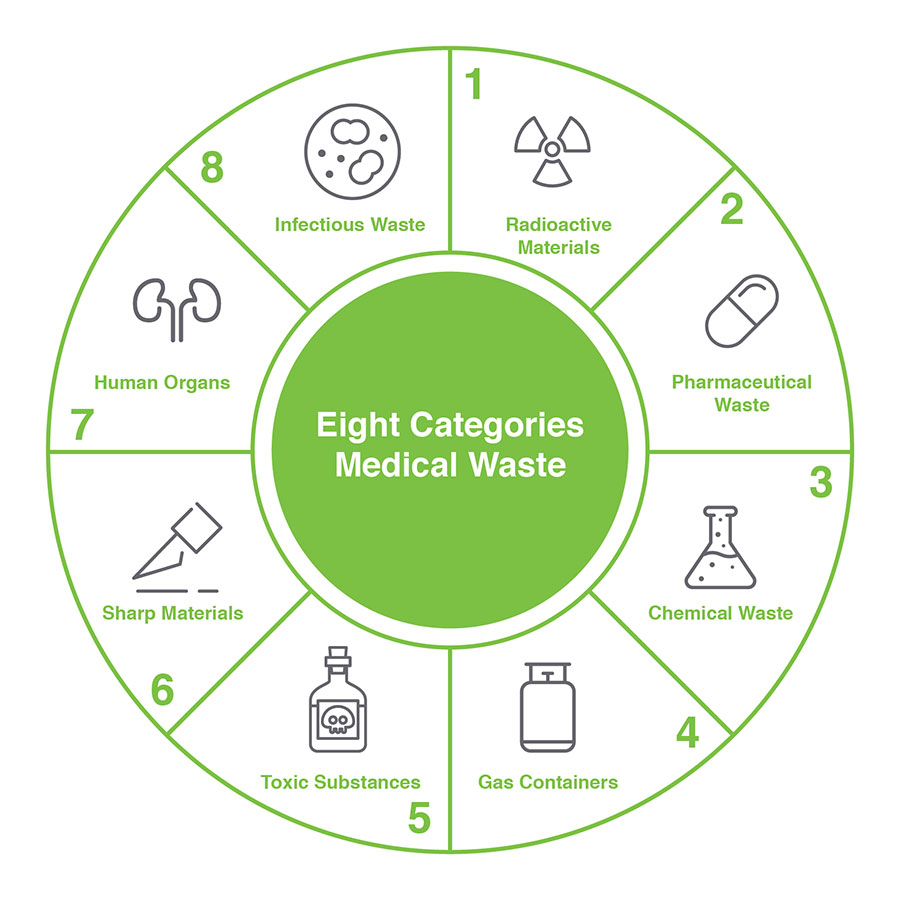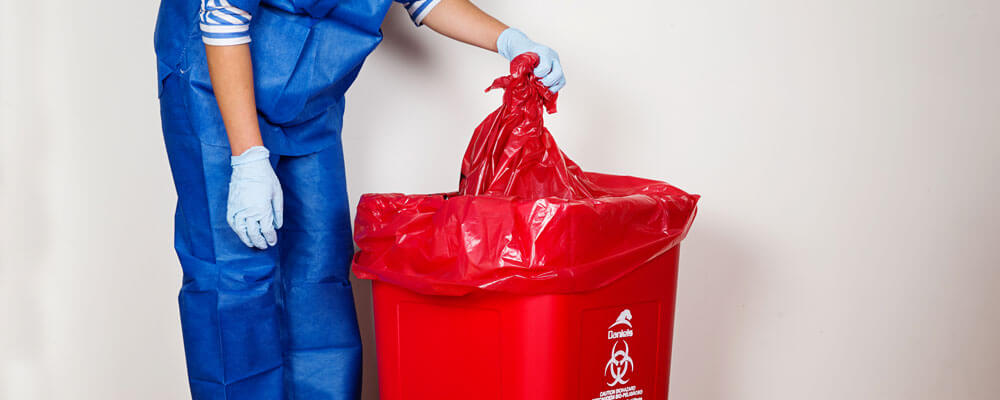Medical Waste Removal Excellence: Elevating Security Specifications in Your Facility
Wiki Article
Reliable and Eco-friendly Medical Garbage Disposal Solutions
In the ever-evolving area of health care, the concern of medical waste disposal continues to be a subject of paramount significance. As health centers, centers, and other healthcare centers aim to offer high quality client care, they have to additionally deal with the difficulty of effectively and responsibly getting rid of their waste - medical waste removal services. In an era where ecological sustainability goes to the leading edge of public consciousness, locating services that are both reliable and environmentally friendly is not just an issue of conformity but likewise a testament to the commitment of medical care establishments in the direction of a greener future. From waste segregation techniques to ingenious reusing efforts, this conversation will check out the various approaches employed to tackle this pushing issue, leaving you captivated and anxious to explore the possible solutions that lie in advance.Waste Partition Practices
Effective waste segregation practices are necessary to ensure the proper and safe disposal of medical waste. Medical waste, that includes products polluted with potentially infectious compounds, have to be taken care of in a manner that reduces the risk of damage to both public health and wellness and the atmosphere. Correct waste partition plays an important function in accomplishing this objective.Waste partition includes the splitting up of different kinds of waste based upon their features and possible dangers. This procedure makes certain that each kind of waste is dealt with and disposed of appropriately (medical waste disposal services with WasteX). It begins at the point of generation, where medical care facilities should have assigned bins and containers for different waste classifications, such as sharps, infectious waste, pharmaceutical waste, and non-hazardous waste
By setting apart medical waste at the source, healthcare providers can stop cross-contamination and decrease the threat of exposure to infectious representatives. This practice additionally helps with the recycling and recuperation of specific materials. For instance, segregating and reusing clean plastics and glass decreases the need for raw products and decreases the ecological impact of medical waste disposal.

Autoclaving and Sanitation Strategies
In order to ensure the appropriate and safe disposal of medical waste complying with efficient waste partition techniques, medical care centers should utilize autoclaving and sterilization methods. Autoclaving is a commonly utilized approach that utilizes high-pressure steam to sanitize medical waste. This process involves putting the waste in a chamber and subjecting it to a mix of high temperature level and stress, which properly eliminates microbes and provides the waste safe for disposal. Autoclaving is particularly effective in sterilizing items such as medical instruments, laboratory devices, and certain types of clinical waste that can stand up to heats. medical waste disposal services with WasteX.This entails treating the waste with chemicals such as ethylene oxide or hydrogen peroxide, which kill microorganisms by disrupting their cellular structure. It is crucial to note that chemical sterilization requires proper handling and disposal of the chemicals utilized, as they can be harmful to human health and wellness and the setting if not managed correctly.
On-Site Waste Therapy Solutions
Health care centers have carried out on-site waste therapy systems to resolve the disposal of clinical waste in a reliable and safe manner. These systems offer a convenient and economical solution for taking care of clinical waste produced within the facility. On-site waste treatment systems utilize numerous technologies to get rid of and treat of medical waste on-site, minimizing the demand for transport to off-site official website centers.One generally made use of on-site waste therapy system is the microwave technology. This technology utilizes microwave power to sanitize and sterilize clinical waste, minimizing its volume and rendering it safe for disposal. Another system is the chemical sanitation innovation, which involves dealing with medical waste with chemicals to kill virus and minimize its dangerous nature. This method is specifically efficient for fluid clinical waste.
On-site waste therapy systems use a number of benefits. They remove the threat of clinical waste being messed up throughout transport, reducing the potential for contamination and exposure to damaging compounds. Furthermore, these systems aid medical care facilities adhere to waste administration guidelines by supplying a reliable and convenient disposal method. On-site therapy systems decrease the overall ecological effect of medical waste by reducing transportation and the need for landfill space.
Recycling and Repurposing Efforts
As healthcare facilities strive for sustainable waste management practices, they are progressively checking out recycling and repurposing efforts as a way of minimizing the environmental effect of medical waste. Recycling and repurposing initiatives involve finding innovative means to reuse or change clinical waste right into brand-new products or materials. This not just aids to lessen the volume of waste that ends up in incinerators or landfills but additionally lowers the intake of resources right here and energy required for making brand-new products.
One example of recycling in the medical care industry is the reprocessing of single-use clinical devices. This not just minimizes the amount of waste generated but also conserves health care centers substantial expenses connected with acquiring brand-new devices.
One more recycling effort entails the recycling of plastic containers, such as medicine containers or syringe casings. These containers can be gathered, arranged, and sent to recycling centers where they are processed, melted down, and changed right into new plastic products. This assists to preserve resources and minimize the need for virgin plastic manufacturing.
Along with recycling, repurposing efforts entail finding alternate usages for clinical waste. For instance, shredded paper waste from medical records or product packaging products can be repurposed as bedding material for animals or as insulation material (medical waste removal services). Organic waste such as food scraps from healthcare facilities can be composted and utilized as plant food in gardens or farming areas.

Renewable Energy Solutions
One effective method to reducing the environmental impact of health care procedures includes executing renewable resource solutions. Medical care centers, such as clinics and hospitals, eat substantial quantities of energy for various purposes, consisting of lights, heating, cooling, and running clinical equipment. By transitioning to renewable resource resources, these facilities can considerably reduce their carbon impact and contribute to a more lasting future.

Executing eco-friendly power solutions in health care centers not just reduces greenhouse gas exhausts but likewise uses lasting cost savings. While the first investment in sustainable energy facilities might be greater, the lasting functional costs of renewable resource systems are significantly lower compared to conventional fossil fuel-based energy sources. Furthermore, eco-friendly power systems are dependable and can offer a undisturbed and secure power supply, making certain continuous healthcare solutions even during power outages or emergencies.
Conclusion
In final thought, implementing ecologically pleasant and reliable medical waste disposal solutions is necessary for maintaining a lasting healthcare system. By embracing waste segregation methods, autoclaving and sterilization techniques, on-site waste treatment systems, reusing and repurposing initiatives, and sustainable energy options, medical care centers can considerably minimize their environmental effect.It begins at the point of generation, where health care centers ought to have marked bins and containers for various waste groups, such as sharps, infectious waste, pharmaceutical waste, and non-hazardous waste.
In order to ensure the safe and appropriate disposal of clinical waste adhering to effective waste segregation methods, medical care facilities should utilize autoclaving and sanitation recommended you read strategies.Healthcare facilities have carried out on-site waste therapy systems to address the disposal of medical waste in a effective and risk-free manner. On-site waste treatment systems make use of different technologies to treat and dispose of medical waste on-site, lessening the demand for transportation to off-site centers.
As health care facilities make every effort for sustainable waste administration methods, they are progressively checking out recycling and repurposing campaigns as a method of reducing the environmental impact of medical waste. - medical waste removal
Report this wiki page